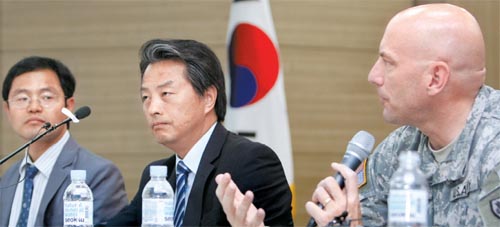Tiny traces of dioxins found at Camp Carroll

A joint investigation team of Korea and the United State gives a briefing on the results of tests on water from outside Camp Carroll yesterday at Chilgok County Office, North Gyeongsang. By Gong Jeong-sik
Tiny amounts of dioxins were found in stream water near Camp Carroll in Chilgok, North Gyeongsang, according to a joint Korea-U.S. investigation team.
The team yesterday announced the results of tests on water outside the camp, where several U.S. veterans have claimed the toxic defoliant Agent Orange was illegally buried three decades ago.
The investigators are continuing to inspect soil outside the camp and water and soil inside it. According to a Korean official in the joint investigation team, it plans to announce the results of the remaining inspections at the end of next month.
Testing on waters outside the camp began on May 27, a week after Steve House and two other former U.S. servicemen told an Arizona television channel that U.S. Forces Korea buried about 250 55-gallon drums of Agent Orange at the camp in 1978, a claim that triggered similar claims of chemical disposal by USFK and a spike in anti-U.S. sentiment among the public. The dioxins in Agent Orange are known cause birth defects and cancer.
The joint investigators said they sampled groundwater in 10 spots and stream water in six others within a 2-kilometer (1.2-mile) radius of the base and conducted a 154-point water quality analysis.
“Dioxins, which are the elements of defoliants, have not been detected in underground water at all,” the joint investigators said in a statement.
The investigators said dioxin was found in stream water from three spots at concentrations of 0.001 to 0.010 picograms per liter, which they said was only one-30,000th to one-3,000th of the permissible level for potable water under U.S. Environmental Protection Agency guidelines.
The Ministry of Environment said further study is needed to verify whether the dioxins were the result of contamination by defoliants from the base.
Environmental activists dismissed the announcement as only a fraction of the investigation and said no conclusion should be made until the results from inspections inside the base come out.
USFK admitted that chemicals were buried in the camp in 1978, but said they were removed over the following years.
By Moon Gwang-lip [joe@joongang.co.kr]
한글 관련 기사 [연합]
캠프캐럴 주변 하천수 극미량 다이옥신 검출
'기준치의 3천~3만분의1…지하수에선 다이옥신 안나와'
지하수 일부 오염물질 기준 초과…'정밀조사 계획'
경북 칠곡군 미군기지 '캠프 캐럴' 주변 하천수에서 극미량의 다이옥신이 나왔지만 지하수에서는 전혀 검출되지 않은 것으로 나타났다.
한미 공동조사단은 16일 조사 결과 발표를 통해 지하수 관정 10개에서 채취한 시료를 분석한 결과, 고엽제 주성분이자 발암물질인 다이옥신이나 '2,4-D', '2,4,5-T' 등은 전혀 검출되지 않았다고 밝혔다.
이번에 시료를 채취한 관정은 캠프 개럴 주변지역 반경 2㎞ 이내의 음용 관정 3개와 비음용 관정 7개를 대상으로 했으며 먹는물 수질기준(58개)을 포함해 154개 항목을 분석했다고 조사단은 설명했다.
조사단은 또 하천수 조사에서는 6개 지점 중 3개 지점에서 극미량(0.001~0.010 pg-TEQ/L)의 다이옥신이 검출됐다고 밝혔다.
조사단은 이같은 검출량은 미국 환경보호국(EPA) 먹는물 기준(2,3,7,8-TCDD 30pg/L)의 3천분의 1에서 3만분의 1에 해당하는 수준이며 최근 왜관지역 기존 조사결과 평균(0.070 pg-TEQ/L)과 비교해도 7분의 1에서 70분의 1수준이라고 전했다.
환경부 관계자는 "하천수에서 나온 극미량의 다이옥신은 대기 이동이나 기존 토양에 축적돼 있다가 검출됐을 수도 있다"면서 "캠프 캐럴 기지내 오염으로 인한 것인지는 추가 조사를 해봐야 할 수 있다"고 말했다.
그러나 3개 지하수 관정에서는 다이옥신 이외의 일부 오염물질이 수질기준을 초과한 것으로 나타났다.
음용관정이었다가 광역상수도 전환을 위해 공사중인 왜관리 1개 관정에서는 휘발성유기화합물(VOCs) 항목인 테트라클로로에텐(PEC)이 기준치를 초과했다.
칠곡종합복지회관의 민방위시설로 개발된 관정은 일반세균과 총대장균이 기준을 넘었고 생활용수로 이용하고 있는 관정에서는 수소이온농도 기준을 초과했다.
환경부는 PEC가 먹는물 수질기준을 초과한 관정지역을 중심으로 오염원에 대한 추가 조사를 벌일 계획이라고 밝혔다.
한미 조사단은 이날 오전 11시 칠곡군청에서 캠프 캐럴 주변 지하수와 하천수 수질조사 결과를 발표하고 오후에는 주민설명회도 가질 예정이다.










with the Korea JoongAng Daily
To write comments, please log in to one of the accounts.
Standards Board Policy (0/250자)